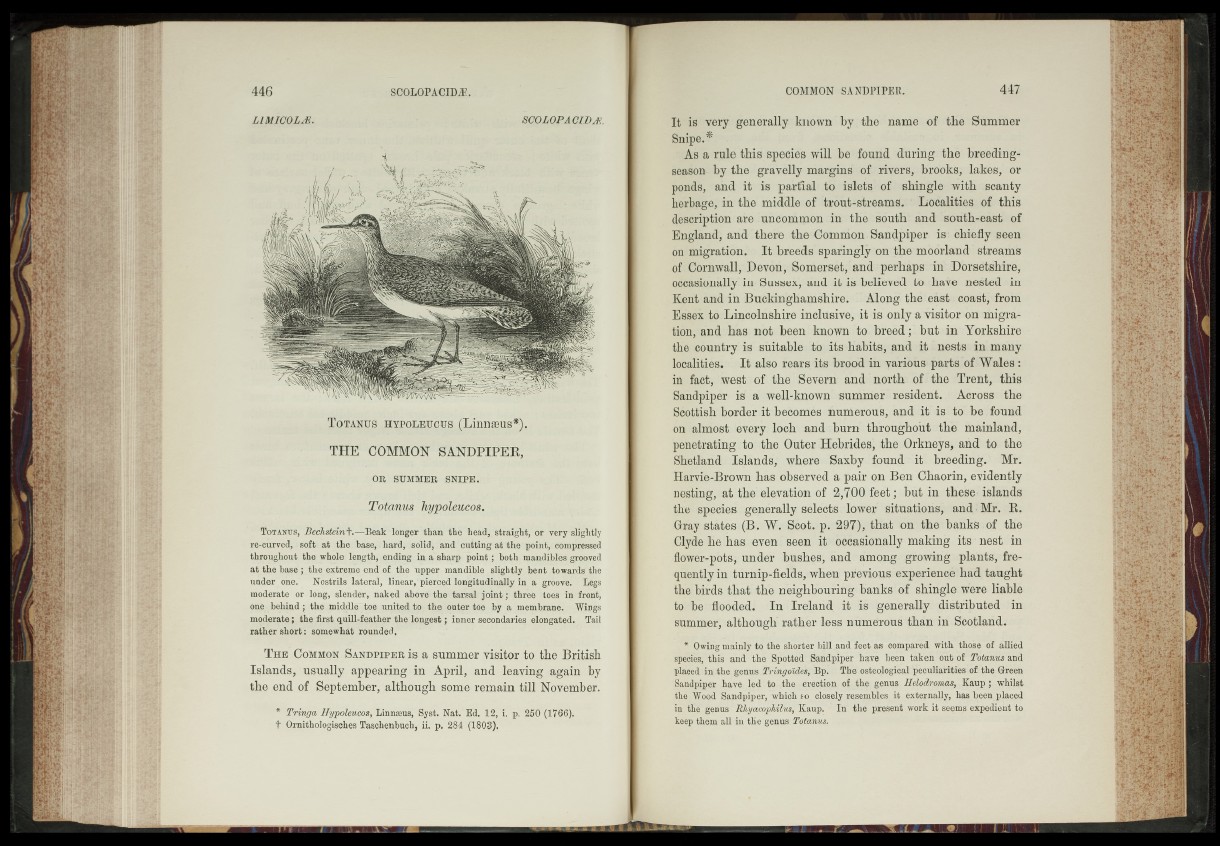
L1UIQOLM. J gL& k \ SCOLOfAGil)Ai.
T otanus hypoleucusjLinnaeus*Y.
THE COMMON SANDPIPER,
lüa SUMMER SNIPE..
, Totanus kypoleucos. .-M
Totahtjs, B ecT istem ^ -i-'B ea k longer th a n 'tte dmad,.'straight, or very slightly
re-curved, \ soft at the base, hard, solid;,and ‘cutting at the point, compressed
throughout the whole,length,tjend|ng in a sharp point; both mandibles grooved
a t the base ; the extreme jsmT.of the upper mandible slightly, bent .towards tjie
under one.* 'lateral, linear,' pierced longitudinally in a grooved Legs
moderate or • long,'slender, naked above the' tarsal?foint‘>} three toes in fropt,
one. behind; the piid^er toe u n ^ d ; to the outer toe-by a membrane. Wings
moderate; the first quill-feather the longest; inner secondaries elongated. Tail
rather short : somewhat rounded.
T h e C ommon S a n d p ip e r is a summer visitor to the British
Inlands, usually appearing in April, and leaving again by
the end of September, although some remain till November.
* Tringa Hypoleucos, Linnaeus, Syst. Nat. Ed. 12,T p. 250 (1766),
t Orpithologisches Taschenbuehf'iillp 284,5”(i?803').
It is very generally known by the name of the Summer
Snipe.*
As a rule this species will be found during the breeding-
season- by the gravelly margins-of ■ rivers, brooks, lakes, or
ponds, and it is partial to islets of shingle with .scanty
herbage, in the middle ©f tröufcstreams. I Localities of this
description are iuncomqaon .in the south' and 'south-east of
England, and there the-Common. Sandpiper, is - chiefly-seen
on migration. > Itr,breeds" sparingly on'themóórland jstream^
of Cornwall, Devon, Somerset, and perhaps in Dorsetshire,
occasionally in Sussex, and ibis believed to havet nested in
Eent and in Buckinghamshire.P Along thé:east: coast, from
Essex tó. Lincolnshire inclusive, it is only a visitor on migration,
and has not. been, known j to breed;, but in Yorkshire
the country is‘.suitable,’to.. its>habits, and:it Lnests. in'many
•localities. It' also rears its brooddn various' parts of Wales:
in fact, west of the. Severn and north; óf I the Trent, this
Sandpiper, is «v,well-known' summer| resident., Across the
Scottish border, it becomes numerous, and it" is - to be, found
on almost -every; loch and burn throughout;:the mainland,
penetrating.: to the Outer Hebrides^ the,Orkneys, and to the
Shetland Islands, where TSaxby found it breeding^ Mr.
Harvie-Brown has observed a pair on Ben Chaorin, evidently
nesting, at the elevation,Vof 2$700 feet; -hut in these- islands
th^-skédies generally selects-'dowey. situations,’ and* Mr. R.
Gray.states,(B'.’sWüScot.'p. 29.7-); that on the banks,of the
Clyde heihas. even,! seen it occasionally making its-nest-in
flower-pots, under hushes, and- among growing .plants,- fre.-
qu'ently in turnip-fields,when previous 'experience,'had taught
the birds that? the neighbouring banks of shingle were liable
to be flooded: ' In Ï Ireland itr-Ss| generally distributed - i in
summer, although' rather less numerous than in Scotland; I
. Qwing mainly to the porter- bO'.and feet as comp,are{l with those of allied
spici¥s^this and' -vhe'^xitSefP Sandpiper have teen taken out’-of Totanus and
placed -in Jshe.^maSTringoïdes^ÏBnp'., ■ The osteqlogical 'peculianti.es .of the Green
Sandpiper -.have; led to ,the ^®ee,tiqgif oj^hei §enus aup ; whilst
the,-Wqod"Sandpip’er, whien-so, closelyA’efiemtleg^it .externally, has heen placed
in the genos RKydcojpMÏus^KampT’* In the present work it se.^ii^’'eip.ejdient to
keep thém-f§J|!in tKe genus Totanus.